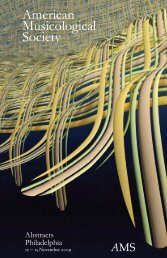Abstracts - American Musicological Society
Abstracts - American Musicological Society
Abstracts - American Musicological Society
Create successful ePaper yourself
Turn your PDF publications into a flip-book with our unique Google optimized e-Paper software.
14 Thursday Morning: Session 1- 12<br />
AMS/SEM/SMT New Orleans 2012<br />
theme in intergenerational dialogue on the islands—as a useful lens for examining how contemporary soca in St. Kitts-Nevis<br />
seeks to create a Kittitian-Nevisian sound that points toward an international -beyond intra-Caribbean—sensibility through<br />
deliberate use of “wutlessness.”<br />
Chromatopes of Noh<br />
Michael Gardiner (University of Pittsburgh)<br />
Although it is widely known that timbre serves an expressive means integral to the instrumental and vocal sounds of noh,<br />
little research has been undertaken to reveal the impact of timbre designs upon conceptions of musical form with any amount<br />
of precision. The following article presents an approach specifically from the vantage point of timbre with the aid of spectrographic<br />
imaging software. Spectrographic images allow one to discuss in detail elements of the acoustic spectrum including<br />
overtones, non-harmonic bands of noise, formants, and changes of intensity. I name these timbre designs “chromatopes”<br />
(chroma meaning color, and topos referring to a spatial motif or path). The first half of the paper reveals a set of spectral connections<br />
between the two drums, the ōtsuzumi and kotsuzumi, and the melodic elements of noh, the nohkan flute and the<br />
voice. The second half of the paper considers the chromatopes that follow from three common introductory sections in noh<br />
performances, a shidai, a nanori-bue, and an issei, and how these timbre designs interact with traditional conceptions of form.<br />
Session 1-12 (SEM/SMT), 10:45–12:15<br />
Analytical Studies of Indonesian Musics<br />
Lisa Gold (University of California, Berkeley), Chair<br />
In Search of Refinement: Manifestation of Alus in Genderan Pathetan in<br />
Performances of Martopangrawit and Prajapangrawit<br />
Maho Ishiguro (Wesleyan University)<br />
After listening to a recording of a gendèr performance by a renowned Javanese musician, Sumarsam makes a comment that<br />
left me wondering for the rest of the week: “pak X’s style is so alus, so refined.” What exactly is it that Sumarsam finds “so alus”<br />
in this particular performance of gendèran? Alus is a Javanese word that is deeply rooted in its culture. The English term that<br />
best expresses this all-encompassing word is refinement. In my studies on alusness in gendèran pathetan, the principal question<br />
is such: is the manifestation of an alus quality possible solely through music? If so, what musical components make one’s<br />
gendèran playing alus and why? If not, what are the associations which belong to the domain outside of music and which play<br />
a role in the Javanese perception of affective properties of music? I analyze gendèran of pathetan pelog lima by Martopangrawit<br />
and Prajapangrawit, two musicians from the court of Surakarta known for their distinctive musical styles. Based on discussions<br />
with musicians of Javanese gamelan, I have constructed criteria for the analysis of musical styles. These criteria deal with<br />
a musician’s choice in manner of playing notes. From the music analysis and interviews with informants it becomes evident<br />
that what is perceived as alus in performances of gendèran is not limited to musical features. Through biographical information<br />
about the two Solonese musicians, I examine the inseparable links between socially alus behaviors and the manifestation<br />
of alusness in a musical context.<br />
Ethnotheory Unravelled: An Analytical Approach to Understanding<br />
Balinese “Rules” for Kendang Arja Improvisation<br />
Leslie A. Tilley (University of British Columbia)<br />
The paired drumming traditions of Bali are known for their intricate interlocking patterns. Drum-strokes on the higher<br />
kendang lanang intertwine seamlessly with patterns of like strokes on the lower kendang wadon to create complex composite<br />
patterns. Almost invariably, these patterns are exactingly composed. Yet, in the cyclic kendang playing of the Balinese dancedrama<br />
Arja, both drummers improvise. How these simultaneously improvising drummers are able to weave their patterns<br />
seemingly effortlessly around one another, often at very high speeds, is an analytical question that has only begun to be investigated<br />
(e.g. Hood, 2002). Most Balinese Arja drummers claim adherence to several broad guiding principles that govern improvisation,<br />
placing the two drums in various opposing roles: emphasizing on- vs. off-beats, for instance, or underscoring beat<br />
structure vs. highlighting a larger cyclic framework. These indigenous “rules,” however, are general guidelines only; the reality<br />
is never that simple, and drummers have considerable freedom within these regulating systems. The purpose of this paper,<br />
therefore, is to elucidate further on these ethnotheoretical categories through musical analysis. Kendang Arja improvisation,<br />
which is made up of small cyclic patterns, lends itself well to a close, microscopic study. Thus, drawing from variation analysis<br />
and musical pattern classification techniques employed by Tenzer (2000), Arom (1991) and Toussaint (2005), I will analyse the










